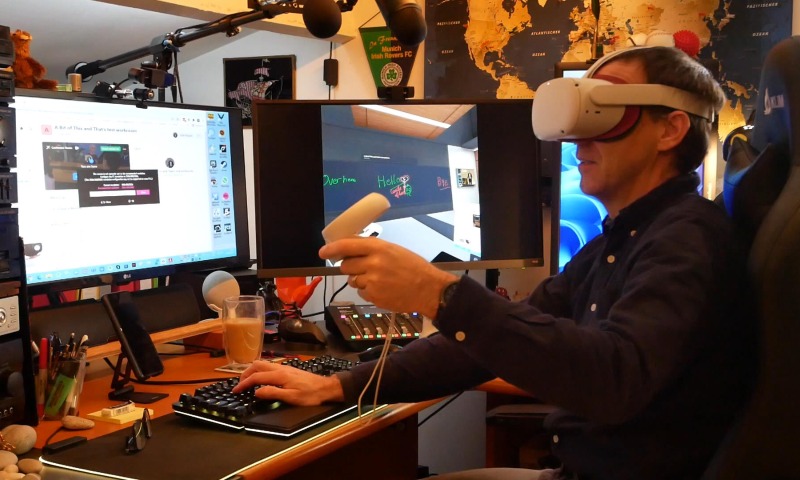Kevin O’Donovan is a highly respected Technology Evangelist, helping companies internalize the implications new technologies may have on their business, by ‘Bridging the Gap’ between the art of the possible versus what is actually feasible for that company today. He is currently co-chair of the VRARA Industrial Metaverse & Digital Twin Committee, a European Commission External Expert, a Member of the Siemens Influencer Community, on the Board of Advisors for IIoT World and ranked by Thinkers360 as a TOP 10 Thought Leader for: Digital Twin, Metaverse and Renewable Energy topics.
Recently, in an exclusive interview with Digital First Magazine, Kevin shared his insights on the impact of new technologies on the energy industry, the role of digital twins in the metaverse, the inspiration behind establishing his company, ‘A Bit of This & That’, his goals for 2023, pearls of wisdom, and much more. The following excerpts are taken from the interview.
According to you, what impact will new technologies have on the energy industry? Also, what is the most innovative advancement in the energy industry right now?
New technologies have always had a transformative impact on the energy industry, but in 2023 I’d argue that we have never seen such a pace of change. The advancements in areas like renewable energy, smart grids, eV’s, energy storage, sustainability, decentralization etc would simply not be possible but for the pace of innovation and the adoption of digital technologies we see today.
These technologies span various areas, from enhancing existing infrastructure with IoT systems to expediting decision-making processes, and even extending to designing future infrastructures such as fusion reactors, small modular reactors, carbon capture plants, hydrogen plants, and electric vehicle charger placements within the grid. Digital Technologies are at the core of all of this and in my opinion, the most ‘innovative’ advancement right now is the adoption of the latest digital twin technology.
What is the role of digital twins in the metaverse?
Within the metaverse, digital twins are the key building blocks for whatever the Metaverse turns out to be. A digital twin is the virtual counterpart of an existing or planned real-world object, system, or environment.
While digital twins are not a new concept, the current generation of digital twin technology excels in integrating data from diverse sources, offering real-time insights, and delivering photorealistic representations, making it distinct and significant in its capabilities.
With todays digital twins, we’ve never had such capabilities to bridge between the physical and digital realms. Today’s digital twins allow us to further our comprehension, foster immersive collaboration, enable all sorts of simulation and ‘what if’ scenario planning in order to empower faster and effective decision-making.
Kevin, can you tell us about your professional journey and areas of interest?
I’ve always been a technology evangelist, always advocating new technologies. It all began in the early 90s with IBM and Compaq, being an OS/2 Ambassador. Since then, I have always been drawn to the progression and interplay of different technologies, such as the likes of client/server, datacentres, cloud computing, Wi-Fi, drones, and AR, VR etc, etc.
So I’ve always been looking at what could be the next big thing, and how will that impact how we work, how we build things, how we collaborate, and how will it change our lives. This has been my area of interest; new technologies and trying to game out their potential implications.

In 2017, you established a boutique technology advisory company, A Bit of This & That. What was the inspiration behind establishing this company and what is its USP?
Around 2016, I was leading Intel’s WW Enterprise Solution Sales efforts in the energy sector. To cut a long story short, Intel asked us to relocate back to Munich. Having worked for prominent American multinational corporations throughout my career, I found myself approaching the age of 50 and looking for a change. So, I made the decision to establish my own company based from here on the Cote d’Azur.
Thus ‘A Bit of This and That’ was born, enabling me to continue advocating around new technology & advising companies on how bridging the gap between the art of the possible and what is feasible.
You are the Co-Chair of the VRARA Industrial Metaverse & Digital Twin Committee. Can you tell us about this global community and its key objectives and vision?
The VR/AR Association (VRARA) is an international organization designed to foster collaboration between spatial computing solution providers and end-users that accelerates growth, fosters research and education, helps develop industry best practices, connects member organizations and promotes the services of member companies.
Now for the Industrial Metaverse and Digital Twin Committee, our charter is;
– Serve as a resource to promote the use of digital twins enabling the industrial metaverse and the opportunities and challenges for the ecosystem.
– The committee will enable the sharing of best practices and information as well as curate industry relevant case studies.
– Drive business, and technical thought leadership for the community.
What, personally, has allowed you the success you have had in the role of a leader in technology?
I honestly believe having hands-on experience is a must have when it comes to exploring new technologies, concepts, and ideas. It’s crucial to try to immerse yourself and truly understand the technology by playing with it, trying things out, and witnessing its real-world applications. You can’t rely on just PowerPoint presentations and online videos. Look to engage with individuals who actively use the technology and learn from their experiences, both the successes and challenges.
Again, its about ‘bridging the gap’ between the art of the possible and reality, and this necessitates comprehending not only the technology itself but also its potential implications of business processes, workflows, and user acceptance. Ultimately, my mantra for success has been to always try it out for myself, to experiment, via a hands-on approach.
What is the best career advice you’ve received and how have you sought to put this into practice?
One of the most valuable career insights I received dates back to the 90’s when a senior VP called me aside one day after a project had gone off the rails. He emphasized the importance of trying out new things, taking risks and said to me, “… it’s OK to make mistakes … Just do not make the same mistake twice!”
Now I like everyone have had my share of mistakes and setbacks. But I’ve always tried to never make that same mistake twice.
What did you learn in 2022 and what are your goals for 2023?
In 2022, I delved deeper into exploring the capabilities of digital twin software, from the likes of the established players like Siemens, Bentley Systems, newer entrants like Blender, Unity, Epic, and Nvidia Omniverse. While I am never going to be an expert in these systems, my goal for 2023 was to expand my understanding of how you go about integrating diverse data sets, different data silos in order to develop the next generation of digital twins. This is non-trivial and it’s complex but we have to understand what is feasible and practical today.
Which technology are you investing in now to prepare for the future?
Generative AI, so that I can understand and articulate the technology under the covers but more importantly become proficient in how to best use the new wave of Generative AI tools, to up my game.
Generative AI unlocks almost limitless creativity, empowers our innovation, allows us to ‘game things out’ in ways we never could before. In my opinion, ‘Prompt Engineering’ will be a critical ‘soft skill’ we’ll all need to develop and expand on in the coming years.
What advice would you offer others looking to build their careers in tech?
Cultivate a passion for always learning. Now you have to start somewhere, so begin by focusing on a technology or solution you’re passionate about. Build your expertise and become recognized for it by your peers. Look to continuously learn and stay updated. Embrace curiosity, explore different approaches, and keep an eye out for emerging technologies, so that you can anticipate their implications. All with the goal of being one of the first to ‘connect the dots’ early, to be seen to be ahead of the curve, thus either maintaining or expanding your own competitive edge.






